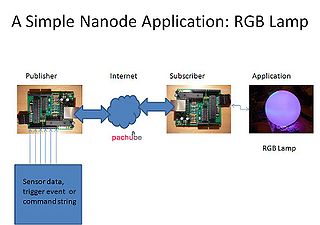Discover Nanode: Difference between revisions
No edit summary |
No edit summary |
||
| Line 35: | Line 35: | ||
[[File:Nanode_application.jpg|320px|right|thumb|A Simple Nanode Application - Web connected RGB Lamp]] | [[File:Nanode_application.jpg|320px|right|thumb|A Simple Nanode Application - Web connected RGB Lamp]] | ||
===Nanode Hardware=== | |||
The Hardware details are included on a separate Hardware page | |||
===Nanode Software=== | |||
===Nanode Documentation=== | |||
All circuit diagrams, board files, details of connectors, partslists can be accessed from the Documentation Page | |||
===Nanode Applications=== | |||
See the Nanode Applications page for details | |||
===Nanode Blogs=== | |||
A list of what others are writing about Nanode | |||
Revision as of 09:25, 24 August 2011
Nanode - An Introduction
Nanode is a low cost, web connected, physical computing platform based on the same technology as Arduino.
Nanode - a 30 second pitch
Nanode is an open source Arduino-like board that has in-built web connectivity. It connects to a range of wireless, wired and ethernet interfaces.
It allows you to develop web based sensor and control systems - giving you web access to six analogue sensor lines and six digital I/O lines.
It costs under £20 as an easy build it yourself kit. Nanode was designed with Hacking in mind.
Some Background
The Nanode is a low cost entry device aimed at network and Internet Connectivity projects.
Its name was originally derived from "Networked Arduino Node" as it essentially opens up the possibility of networking Arduino-like devices both to the internet, and locally using a mix of wired and wireless networks.
It has been conceived as an experimental platform, an enabling technology, which will allow applications to be developed at minimum cost and hassle.
It combines the functionality of the Arduino and an ethernet shield onto the one small board. This literally halves the cost of a net connected Arduino platform.
It has been designed with low cost hacking in mind and can be built easily for under £20 - so that it will appeal to those on a tight budget.
It uses the popular Arduino environment so will be familiar to many. It also accepts Arduino shields, and a wireless shield based on the popular RFM12 device is planned. This will open up the Nanode to wireless networking and creating bridges between wireless, and wired networks and the Internet.
Nanode consists of a small PCB which has the ATmega328 microcontroller, some glue logic, the ENC28J60 ethernet controller and a Magjack ethernet connector. The board only uses through-hole and DIL conventional components - so that it can be easily assembled by anyone who has basic soldering skills.
It makes an ideal project for a teaching workshop on web connectivity, and as such will appeal to Hackspaces for advanced Arduino workshops.
Nanode Hardware
The Hardware details are included on a separate Hardware page
Nanode Software
Nanode Documentation
All circuit diagrams, board files, details of connectors, partslists can be accessed from the Documentation Page
Nanode Applications
See the Nanode Applications page for details
Nanode Blogs
A list of what others are writing about Nanode

